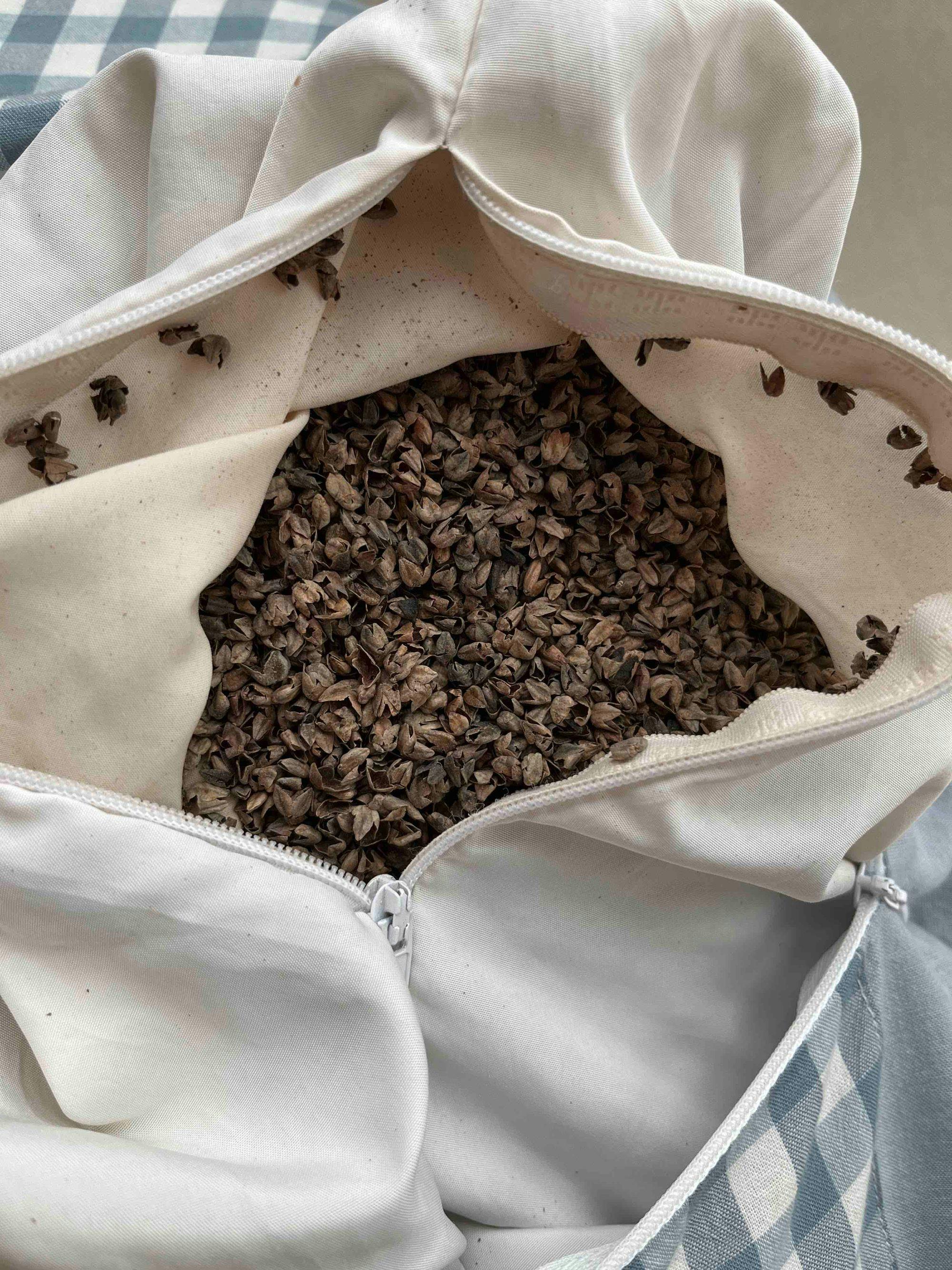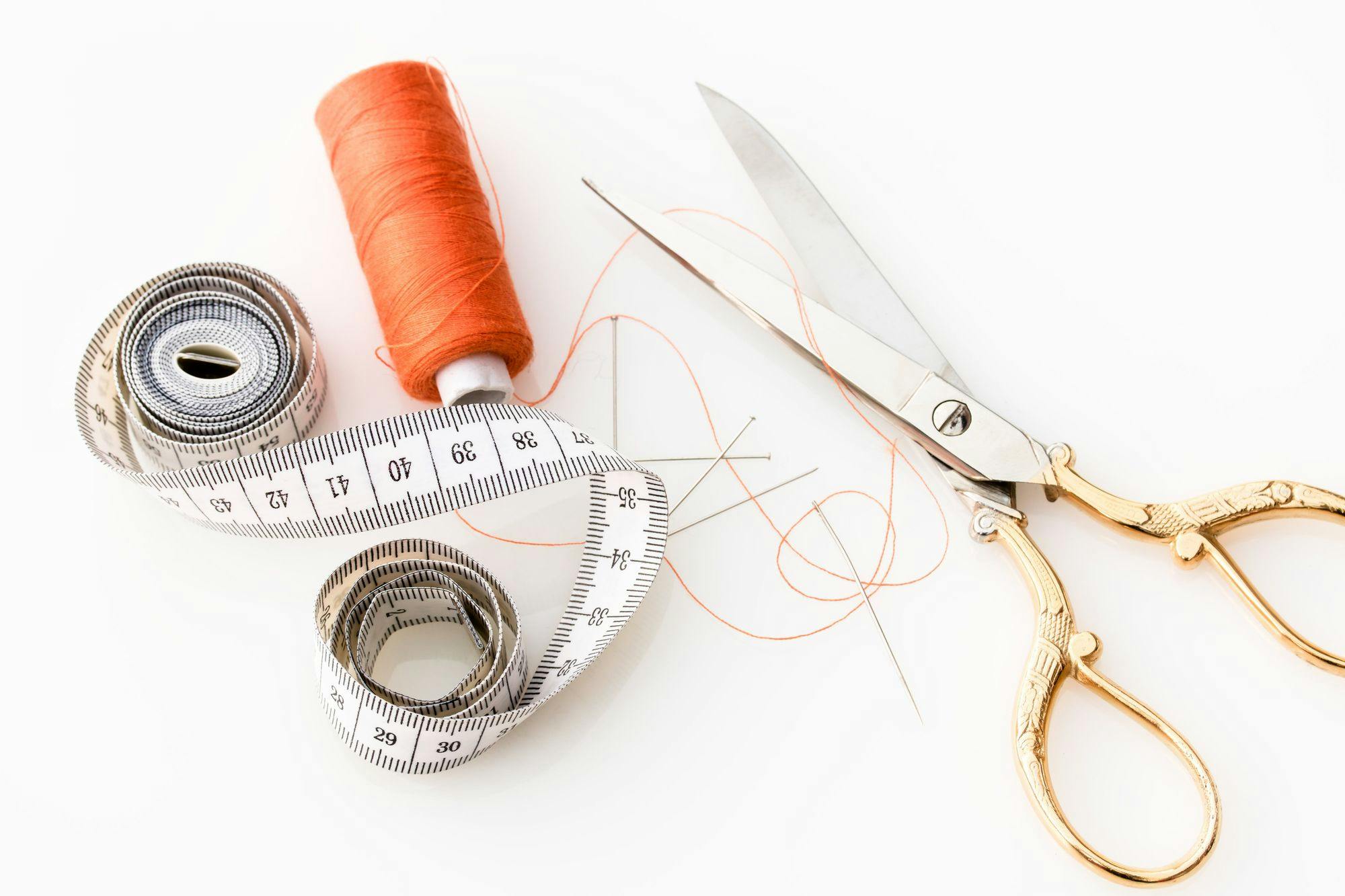Buckwheat pillows are filled with buckwheat hulls, which offer adjustable support that conforms to the shape of one's head and neck. Buckwheat hulls are a natural, biodegradable material that provides a firm sleep surface.
Making a buckwheat pillow is a fulfilling project to create a personalized comfort. With materials that are commonly available and a straightforward assembly process, individuals can create a custom buckwheat pillow tailored to their specific size and firmness preferences.
Composition of Buckwheat Pillows
Before going into the details to DIY a buckwheat pillow, it is important to understand the composition of buckwheat pillows.

Buckwheat Pillow Hulls
The main component of a buckwheat pillow is the buckwheat hulls themselves. These hulls provide firm support that conforms to the shape of your head and neck.

Buckwheat Pillow Case
My buckwheat pillow case is typically made of durable materials like cotton or canvas, which need to withstand the weight and friction of the hulls.
It's essential that the fabric is breathable to allow airflow and prevent overheating during the night.
Buckwheat Pillow Case Zipper
An important feature of my buckwheat pillow case is that it has a zipper, which allows me to add or remove hulls to adjust to my desired pillow loft and firmness.
Buckwheat Pillow Covers
For additional protection and comfort, I use buckwheat pillow covers. They are usually soft and can be removed and washed, helping to maintain hygiene.
The fabric for these covers varies, with options like organic cotton being popular for its natural feel.
Gathering Materials
To successfully create a DIY buckwheat pillow project, one needs high-quality buckwheat hulls, suitable fabric, and the right sewing tools.
Selecting the right materials can ensure the comfort and longevity of the pillow.
Buckwheat Hulls
Securing the main filling for your pillow involves finding buckwheat hulls. They are a natural, supportive material that conforms to the shape of the head and neck.
One should purchase enough to fill their intended pillow size—typically 4 to 8 pounds for a standard sized pillow (20 x 26 inches). Check out our article on how much buckwheat hulls to fill a buckwheat pillow.
Fabric Choices
The choice of fabric for the pillow case greatly impacts the pillow's feel and durability. Cotton is popular for its breathability and softness, while organic options offer a chemical-free rest.
Plan for a fabric piece large enough to accommodate your pillow size, plus extra for seam allowance.
Thread and Tools
High-quality thread is vital to ensure the pillow's seams hold tight over years of use. A sewing machine, scissors, and measuring tape are the basic tools needed.
A zipper is optional but recommended for easy removal and washing of the pillow cover.

Selecting the Right Pillow Case Fabric
When creating a buckwheat pillow, the choice of fabric for the pillow case is crucial as it directly correlates with the comfort and durability of the final product.
A robust material ensures the pillow withstands years of use, while softness contributes to a comfortable night's sleep.
Suitable Fabrics
- Cotton muslin: This natural fiber is commonly recommended due to its softness and availability in various weights, which can be tailored to personal preference.
- Medium weight fabric: For a standard size pillow, a fabric weighing between 5-7 oz. per yard is appropriate.
- Lightweight fabric: Smaller, Japanese-style pillows may use materials as light as 3-4 oz. per yard.
Considerations for Durability
- Natural fibers: These are preferable for their breathability and durability.
- Ease of maintenance: If opting to use a zipper, select one that will not easily unzip under pressure to maintain the pillow's shape and longevity.
Measuring and Cutting the Fabric
When creating a buckwheat pillow, precise measurement and cutting of the fabric is crucial for a well-fitted final product.
The process begins with deciding on the pillow size. The standard pillowcase size is about 20 in × 26 in (51 cm × 66 cm).
When making a pillowcase, add approximately 1 in (2.5 cm) to each dimension to account for the seam allowance.
Sample Measurements for a Standard Pillowcase
- Width: 21 inches (including seam allowance)
- Length: 27 inches (including seam allowance)
Next, one should lay the fabric on a flat surface and mark the measurements using a fabric marker. It’s essential to ensure that the lines are straight and the corners are at right angles to avoid a skewed pillowcase.
Cutting Instructions
- Use a ruler and a fabric marker to mark the dimensions on the fabric.
- With sharp fabric scissors, cut along the marked lines carefully.
- Ensure that the edges are smooth and even.
For a professional finish, one may also use a rotary cutter and cutting mat, which can help achieve straighter edges.
After cutting, it’s important to check the fabric pieces are of the correct size before moving on to the sewing process.
This preparation will lead to a precisely-sized pillow that comfortably encases the buckwheat filling.
Sewing the Pillowcase
Creating a durable and comfortable buckwheat pillowcase involves precise stitching and the option of adding a zipper for easy maintenance.
Stitching the Edges
Start by cutting two pieces of fabric to their desired pillowcase size, typically around 20 inches by 26 inches for a standard pillow.
Then use a straight stitch on a sewing machine and leave a half-inch seam allowance. It's crucial to backstitch at the beginning and end to secure the stitches.
Adding a Zipper
A zipper can be installed on one end of the pillowcase, which allows for easy removal and cleaning.
I suggest to select a zipper that is slightly shorter than the width of the pillowcase. Sew the zipper in place with a zipper foot, ensuring that it's centered and the edges of the fabric are aligned.
Preparing the Buckwheat Hulls
Before making a buckwheat pillow, it is essential to select high quality hulls and performing thorough cleaning and drying processes.
Sourcing Quality Hulls
Selecting high-quality buckwheat hulls is crucial for creating a durable and comfortable pillow.
One should look for hulls that are specifically labeled as non-toxic and pesticide-free. Providers often mention whether the hulls are sourced organically, which can be a valuable indicator of quality.
It's important to acquire hulls that are intact and not crushed to maintain the pillow's structure and airflow.
Cleaning and Drying
Once the buckwheat hulls have been sourced, they must be cleaned to remove dust and any residual plant matter.
While some manufacturers do not use detergents, others may extensively wash the hulls. After cleaning, the hulls should be dried completely to prevent the growth of mold.
If one is cleaning hulls at home, they can be laid out on a flat surface and turned occasionally to ensure even drying. It's important to ensure the hulls are completely dry before using them to fill a pillow.
Filling the Pillow with Buckwheat Hulls
When one is ready to fill their pillow with buckwheat hulls, I suggest to use a funnel or a pour spout for a controlled transfer of the hulls into the pillowcase.
The quantity of buckwheat hulls required typically ranges from 4 to 8 pounds for a standard-sized pillow, allowing for a firm yet moldable filling.
Materials Needed:
- Buckwheat hulls
- Pillowcase with zipper or opening
- Funnel or pour spout
- Measuring cup (optional)
Step-by-Step Guide:
- Prepare the Pillowcase: For convenience, buckwheat pillows often feature a zipper. If one is using a zippered pillowcase, they should unzip it to access the interior.
- Measure Hulls: While not absolutely necessary, some might choose to measure the buckwheat hulls to ensure their pillow reaches their desired firmness.
- Fill the Pillow: Position the funnel or pour spout into the pillowcase opening and gradually pour in the buckwheat hulls. One should fill it enough to allow the pillow to mold to the shape of their head but not so full that it becomes rigid.
- Adjust the Filling: It's essential to test the pillow and remove or add buckwheat hulls to reach the perfect degree of support.
- Seal the Pillow: Once satisfied with the amount of filling, one should close the zipper or stitch the opening shut if not using a zippered case.
A reminder: It's recommended to leave a bit of space inside the pillow after filling to let the buckwheat hulls move freely, thus conforming to one's head and neck for optimal support.
Sealing the Pillow
After filling the pillow with the desired amount of buckwheat hulls, it's important to securely seal it to prevent any spillage.
There are several methods one may choose depending on the materials and tools available, as well as personal preference.
Hand Sewing
For those who prefer the traditional method and possess basic sewing skills, hand stitching is a viable option.
One can use a:
- Needle; and
- Strong thread
Steps:
- Fold the open edge of the fabric inward to create a clean hem.
- Seam the edge using a slip stitch or a ladder stitch for a nearly invisible closure.
Machine Sewing
For a quicker and often stronger seal, using a sewing machine is recommended. Sew along the open edge, making sure to backstitch at the beginning and end of the seam for extra security.
The sewing machine techniques for inserting a zipper can also apply if one wishes to make the pillow refillable.
Adding a Zipper
To add a zipper:
- Pin the zipper in place along the open edge.
- Use a zipper foot on the sewing machine to stitch around it.
Velcro or Button Closure
Alternatively, one can opt for Velcro strips or buttons if they want adjustable firmness or the ability to easily remove the hulls for washing the outer case.
This involves:
- Sewing Velcro strips to the inner edges of the opening.
- Or attaching buttons and crafting buttonholes.
A properly sealed pillow ensures the longevity and proper function of a buckwheat pillow, keeping the hulls in place for consistent support.
Customizing Your Pillow
A significant advantage of a buckwheat pillow is its adjustable firmness. To achieve this, one can simply add or remove buckwheat hulls to suit their comfort level.
The presence of a zipper in the pillow design is crucial; it facilitates easy access to the pillow's interior. For instance, adding a zipper to your pillow provides the flexibility to adjust the amount of filling, which directly affects how firm the pillow feels.
When the pillow feels too firm, removing some hulls can soften the feel, whereas adding hulls can increase support.
A person can start with an approximate amount of hulls and then adjust incrementally to find the perfect balance that supports their head and neck according to individual needs and sleeping positions.
YZ Li
YZ, an engineer with a PhD based in the San Francisco Bay Area, brings practical expertise to Restful Guides. Focused on simple, effective ways to improve sleep and relaxation, YZ offers easy-to-follow advice on choosing the right pillows, bedding, and meditation techniques for a better, more restful life.
